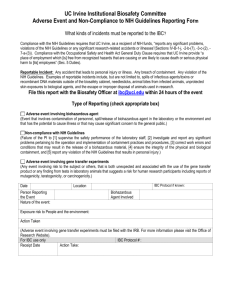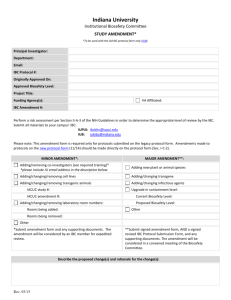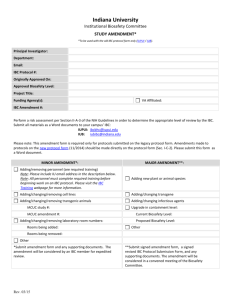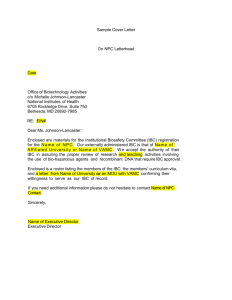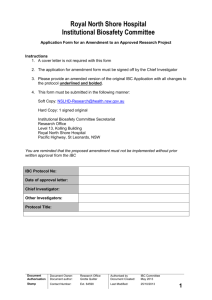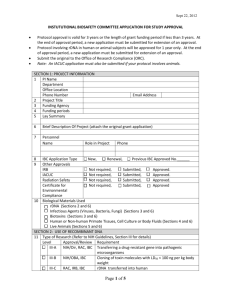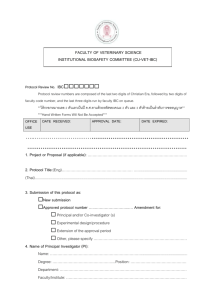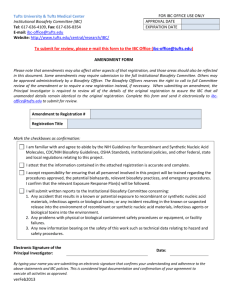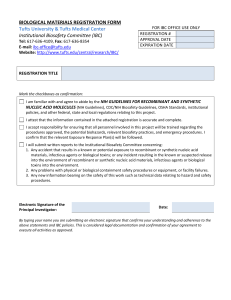Supplemental Document - Office of Research Compliance
advertisement
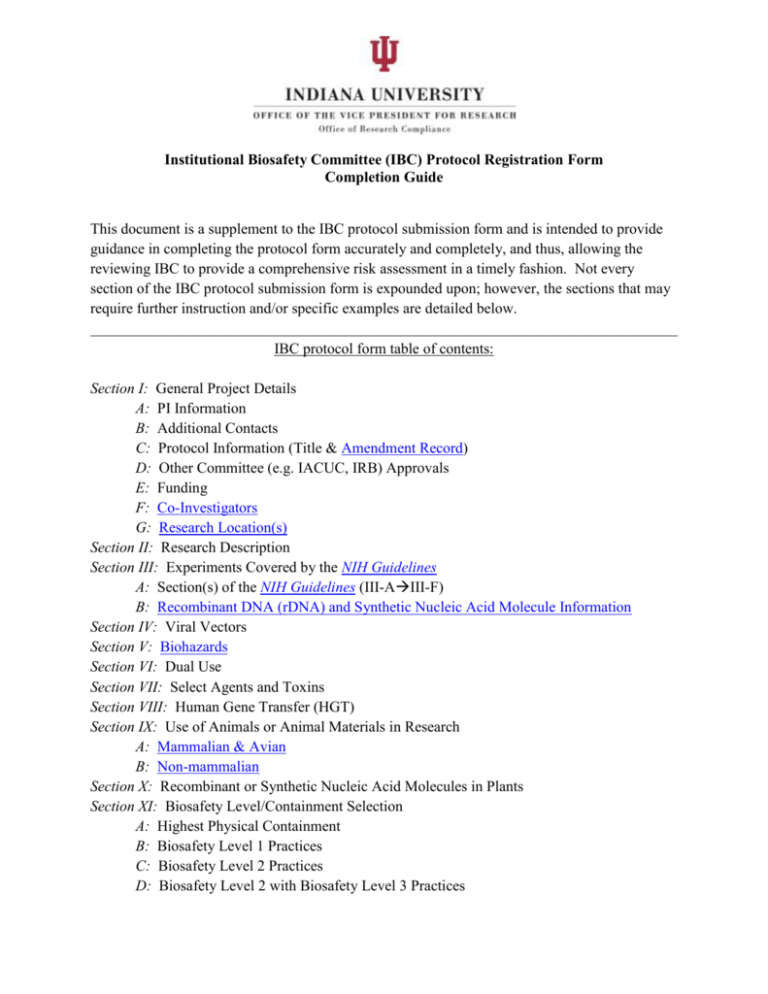
Institutional Biosafety Committee (IBC) Protocol Registration Form Completion Guide This document is a supplement to the IBC protocol submission form and is intended to provide guidance in completing the protocol form accurately and completely, and thus, allowing the reviewing IBC to provide a comprehensive risk assessment in a timely fashion. Not every section of the IBC protocol submission form is expounded upon; however, the sections that may require further instruction and/or specific examples are detailed below. ______________________________________________________________________________ IBC protocol form table of contents: Section I: General Project Details A: PI Information B: Additional Contacts C: Protocol Information (Title & Amendment Record) D: Other Committee (e.g. IACUC, IRB) Approvals E: Funding F: Co-Investigators G: Research Location(s) Section II: Research Description Section III: Experiments Covered by the NIH Guidelines A: Section(s) of the NIH Guidelines (III-AIII-F) B: Recombinant DNA (rDNA) and Synthetic Nucleic Acid Molecule Information Section IV: Viral Vectors Section V: Biohazards Section VI: Dual Use Section VII: Select Agents and Toxins Section VIII: Human Gene Transfer (HGT) Section IX: Use of Animals or Animal Materials in Research A: Mammalian & Avian B: Non-mammalian Section X: Recombinant or Synthetic Nucleic Acid Molecules in Plants Section XI: Biosafety Level/Containment Selection A: Highest Physical Containment B: Biosafety Level 1 Practices C: Biosafety Level 2 Practices D: Biosafety Level 2 with Biosafety Level 3 Practices Section XII: Person Protective Equipment (PPE) & Laboratory Practices A: PPE and Safety Equipment selection(s) B: Laboratory Practices selection(s) C: Laboratory Access D: Health Surveillance/Immunization Section XIII: Decontamination and Waste Disposal Procedures A: Lab/Surface Disinfectant B: Solid Waste C: Liquid Waste D: Infectious Sharps E: Equipment Decontamination procedure(s) Section XIV: Reporting Section XV: Investigator Statement & Signature ______________________________________________________________________________ IBC protocol form – Section-specific Guidance: Section I-C-1. Amendment Record: Indicate the amendment number Indicate the date that the amendment was submitted Select the amendment type based upon the option selected in the “Amendment Summary.” After making the appropriate selections in the “Amendment Record” table, please incorporate all proposed changes in the IBC protocol form itself where appropriate. Amendment submissions will only be reviewed by the IBC in the context of the whole, previously-approved project. Section I-F. Co-Investigators: Please provide the full name and IU e-mail address for all personnel included on the IBC protocol form. “Title/Job Description” Example: o Lab Technician/Running PCR o Graduate Student/Conducts various experiments o Post-Doctoral Student/Supervises graduate student experiments All personnel must complete the NIH Guidelines Training, instructions as follows: *IU-Bloomington investigators will have to momentarily submit NIH Guidelines quiz answers to the IBC Office due to restrictions concerning online training. * Access E-Training via OneStart 1. Log in to your OneStart account, 2. Select the “E Training” option from the left-hand menu, and 3. Select the “Launch E Training” button. Enroll in the Course 1. Select the “Catalog” box. 2. Follow the pathway above: CatalogUniversity-wideEnvironmental Health & SafetyIUPUI & IUPUCOnline Training, and 3. Click the “Enroll” button to the right of the NIH Guidelines training for IUPUI. Once Enrolled, Access My Courses 1. Select the “My Courses” box. 2. Follow the pathway above: My CoursesUniversity-wideEnvironmental Health & SafetyIUPUI & IUPUCOnline Training, and 3. Click the “Open” button to the right of the NIH Guidelines training for IUPUI. 1. Launch the presentation first, 2. Launch the “Research Location Information” once the presentation is complete and input your specific lab association, and 3. Launch the quiz and answer the questions to receive your score. Section I-G. Research Location(s): “Research Activities Performed” Example: o Animal Surgery o Aliquotting o Blood draw o Animal Housing o Tissue Preparation o PCR “Research Activities Performed” column is not meant to be a detailed description, simply a quick reference of activities being performed for biosafety staff. Section III-B. Recombinant DNA (rDNA) and Synthetic Nucleic Acid Molecule Information: Please note any intermediate host(s) prior to final host(s) in Column 2. If a significant number of plasmids exist in a given project, a supplemental spreadsheet may be submitted with the protocol form in lieu of completing Table III-B to list said plasmids. Sec. III-B Table Example: What is the gene or transcription product Source Species of inserted DNA Human Jelly Fish Plasmid and/or Vector(s) to be Host(s) to be used used Plasmid - pSC101, cDNA, microRNA, E.coli Co1E1, pMB9, siRNA, shRNA, (HBA1, HBA2, HBB) for iron pBR322 binding in hemoglobin. Human Cells If known to be harmful (e.g. Oncogenic, Toxic, Mutated Gene) to researcher or environment, please describe: Lentiviral Vector, Blue Fluorescent Gene (HBA1, protein (EBFP, EBFP2, HBA2, HBB) for Azurite) iron binding in hemoglobin. Section V. Biohazards: Sec. V Table Example: (Micro)Organism; Potential Routes of Transmission (check [X] all applicable routes ) Zoonotic ? (Y/N) Contain ment Risk Level/Bio Group safety (RG) Level (BL) Biological Material: ATCC Humans, animals Human CD34 cells Angiogenic Core, IUSM Humans Diphtheria Toxin Sigma Humans, Mice RG2 BL2 X RG2 BL2 X X X X X X Direct contact mucous membranes P.aeruginosa Inhalation Direct contact open wound Infectious Host Range Ingestion Source Inoculation Blood or other Bloodborne Pathogens material; Human Cells/Cell Lines; NonHuman Primate and animal fluids, cells or tissuesI; Biological Toxin X X X X X X Animal Species Source of Animal Mouse C57BL/6 Jackson Labs Zebrafish UMass Knockout (KO), Knock-In (KI), Transgene (T) Section IX-A. Use of Animals or Animal Materials in Research: Sec. IX-A Table Example: Gene Name Potential Hazard(s)? Please Biological Source list. of Gene (human/animal) T Htr1a (5hydroxytrypta mine (serotonin) receptor 1A) Mouse N/A T SLC24A5 (solute carrier family 24 member 5) Synthetic N/A Section IX-B. Use of Animals or Animal Materials in Research: Examples of harmful non-mammalian animals include those containing invasive cells, compounds toxic to humans, and any possible activational viruses that pose a risk to humans. A supplemental spreadsheet listing all non-mammalian strains can be submitted with the protocol form as the mammalian/avian table is not sufficient for non-mammalian animals.

